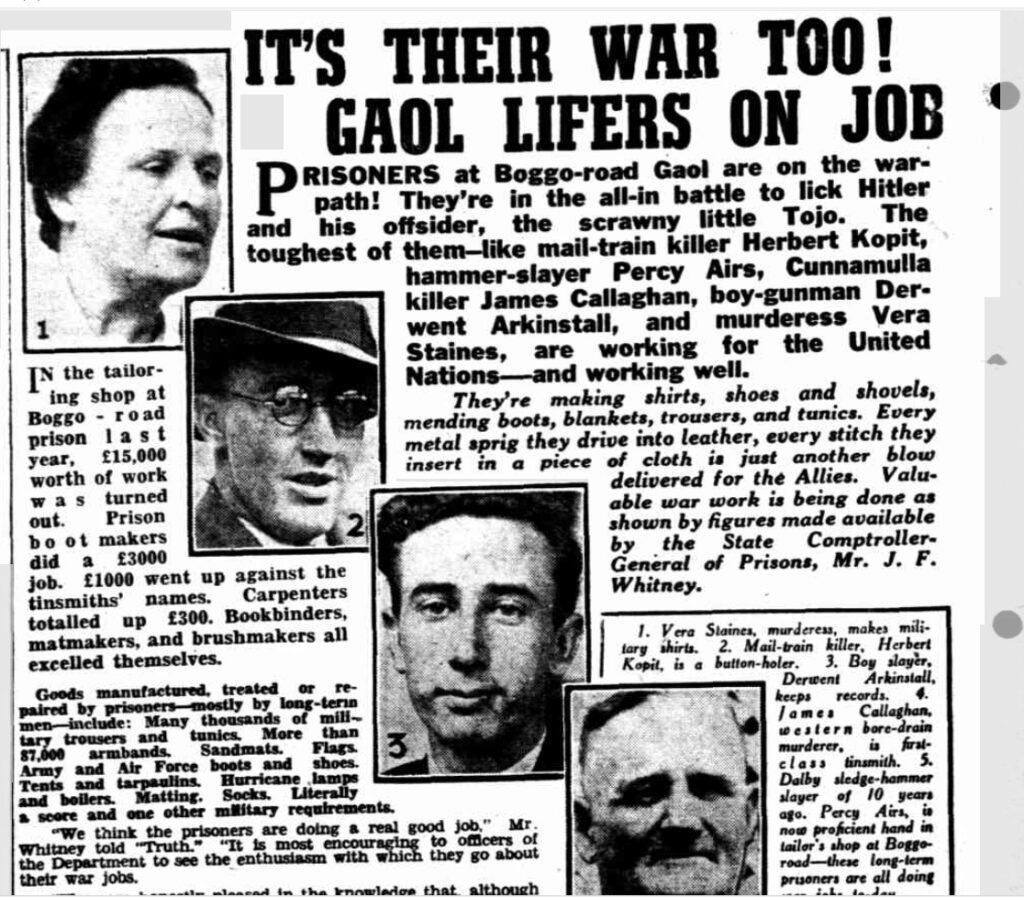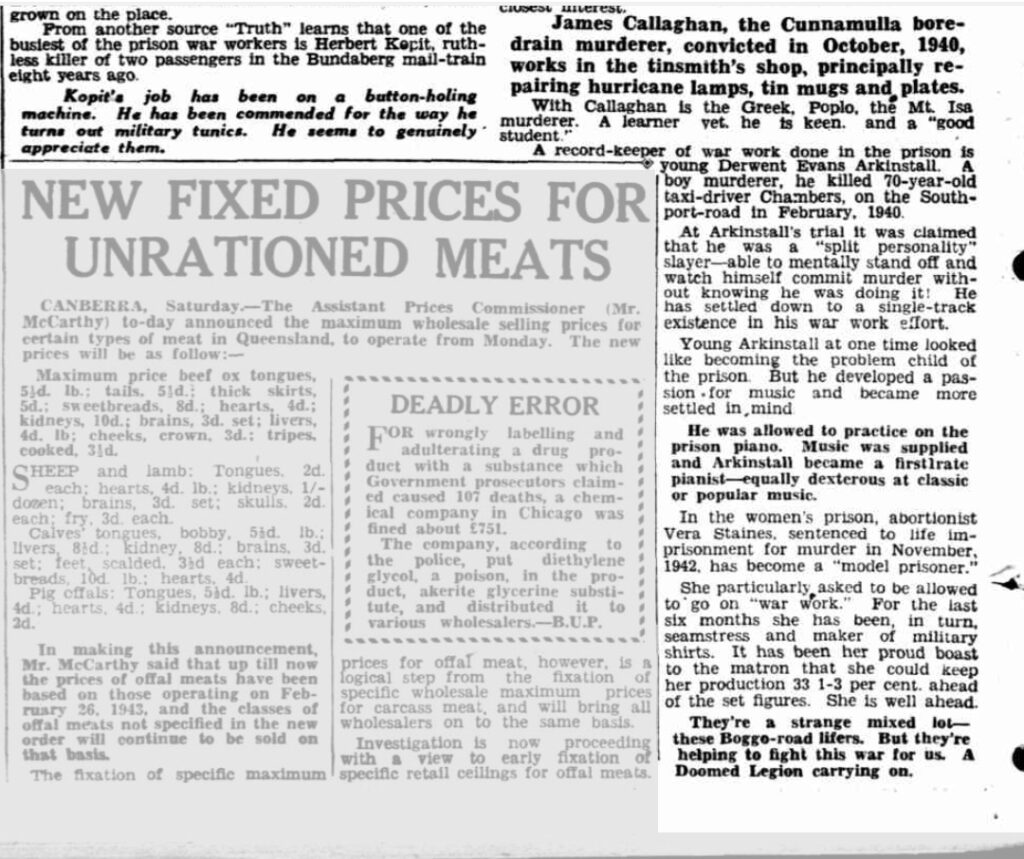The ‘Doomed Legion’ who ‘merely wanted to help Australia’: The role of Prisoners during World War II
The ‘Doomed Legion’ who ‘merely wanted to help Australia’: The role of Prisoners during World War II
Remembrance Day, November 11 marked the 106th anniversary of the armistice that ended fighting with Germany in World War I and commemorated those killed in both World Wars.
While World War II was being waged on the other side of the world, adding to the efforts were Australian prisoners housed at Boggo Road Gaol.
A look back at some news articles from the early 40s reveals the work of prisoners – undertaking reformative treatment – bears striking similarities to efforts in Queensland prisons today.
Drawing similarities to today’s work camps, prison farms, and community service, prisoners were put to work to support troops serving their country.
Below, we look back at how men and women convicted of murder assisted our troops on the front line.

STATE PRISONERS HELP WAR EFFORT – The Courier-Mail, Mon 17 March 1941
Boggo Road Gaol prisoners had almost completed the construction of a producer gas unit, and, if it was a success, others of the same type would be built in the goal, said the Minister for Health and Home Affairs (Mr. Hanlon), on Saturday.
Construction of these units would assist the State if petrol shortage became acute. The work would be done by prisoners during their ordinary work hours.
Thousands of ARP arm bands, tables, and a smoking set had been built by the prisoners in Queensland with no thought of reward. They merely wanted to help Australia.
Mr Hanlon added that Queensland goals held only 400 prisoners at present.
Reformative treatment and the improvement in living conditions had assisted in the gradual decline of the prison population, said the Comptroller-General of prisons (Mr J F Whitney).

IT’S THEIR WAR TOO! GAOL LIFERS ON JOB – “Truth”, 14 May 1944
PRISONERS at Boggo-road Gaol are on the war path! They’re in the all-in battle to lick Hitler and his offsider, the scrawny little Tojo. The toughest of them – like mail-train killer Herbert Kopit, hammer-slayer Percy Airs, Cunnamulla killer James Callaghan, boy-gunman Der went Arkinstall, and murderess Vera Staines, are working for the United Nations — and working well.
They’re making shirts, shoes and shovels, mending boots, blankets, trousers, and tunics. Every metal sprig they drive into leather, every stitch they insert in a piece of cloth is just another blow delivered for the Allies. Valuable war work is being done as shown by figures made available by the State Comptroller General of Prisons, Mr. J. F. Whitney.

SPORTS GEAR FOR DIGGERS – “Truth”, 14 May 1944
Many a digger playing cricket in New Guinea, or in one of the forward areas, has wielded a bat made by prisoners in Boggo-road! That bat has been shaped from wood grown on one of the prison farms. The timber was felled by prisoners, it was hauled to saw-mills and cut up by prisoners in prison mills!
Baseball bats, bails and stumps by the hundred have been made by gaolbirds from prison-grown and prison treated timber.
The Red Cross has had many occasion to thank prison authorities for contributions of fruit and vegetables from the gaol gardens.
All manner of first-class produce has been supplied. The gardens produce an estimated value of about 200 pounds a year.
Mr Whitney claims, with pride, that the Palen Creek prison farm is so well stocked that, even in drought, a ton and a half of feed can be given to stock every day for five months. It comes from silos and stores produce on the place.
From another source “Truth” learns that one of the busiest of the prison war workers is Herbert Kopit, ruthless killer of two passengers in the Bundaberg mail-train eight years ago.
Kopit’s job has been on a button-holing machine. He has been commended for the way he turns out military tunics. He seems to genuinely appreciate them.
Kopit, probably the State’s most callous murderer, who several times tried to suicide in the early days of his sentence, is a much changed man.
With him in the tailoring shop is Percy Airs, former policeman, who murdered his employer by bashing his head to pulp with a sledge hammer near Dalby 10 years ago. Airs works hard with a cutting-out scissors. He likes the job!
Airs never misses a news session on the gaol wireless. He follows every act of war drama with the closest interest.
James Callaghan, the Cunnamulla bore drain murderer, convicted in October, 1940, works in the tinsmith’s shop, principally repairing hurricane lamps, tin mugs and plates.
With Callaghan is the Greek, Poplo, the Mt isa murderer. A learner vet, he is keen and a “good student”. A record-keeper of war work done in the prison is young Derwent Evans Arkinstall. A boy murderer, he killed 70-year-old taxi driver Chambers on the South port road in February, 1940.
At Arkinstall’s trial it was claimed that he was a “split personality” slayer – able to mentally stand off and watch himself commit murder without knowing he was doing it! He has settled down to a single-track existence in his war work effort.
Young Arkinstall at one time looked like becoming the problem child of the prison. But he developed a passion for music and became more settled in mind.

He was allowed to practice on the prison piano. Music was supplied and Arkinstall became a first rate pianist – equally dexterous at classic or popular music.
In the women’s prison, abortionist Vera Staines, sentenced to life imprisonment for murder in November, 1942, has become a “model prisoner.”
She particularly asked to be allowed to go on “war work”. For the last six months she has been, in turn, seamstress and maker of military shirts. It has been her proud boast to the matron that she could keep her production 33 1-3 per cent ahead of the set figures. She is well ahead.
They’re a strange mixed lot – these Boggo Road lifers. But they’re helping to fight this war for us. A doomed legion carrying on.

